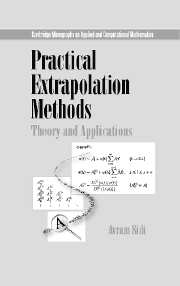Preface
Published online by Cambridge University Press: 25 February 2010
Summary
An important problem that arises in many scientific and engineering applications is that of finding or approximating limits of infinite sequences {Am}. The elements Am of such sequences can show up in the form of partial sums of infinite series, approximations from fixed-point iterations of linear and nonlinear systems of equations, numerical quadrature approximations to finite- or infinite-range integrals, whether simple or multiple, etc. In most applications, these sequences converge very slowly, and this makes their direct use to approximate limits an expensive proposition. There are important applications in which they may even diverge. In such cases, the direct use of the Am to approximate their so-called “antilimits” would be impossible. (Antilimits can be interpreted in appropriate ways depending on the nature of {Am}. In some cases they correspond to analytic continuation in some parameter, for example.)
An effective remedy for these problems is via application of extrapolation methods (or convergence acceleration methods) to the given sequences. (In the context of infinite sequences, extrapolation methods are also referred to as sequence transformations.) Loosely speaking, an extrapolation method takes a finite and hopefully small number of the Am and processes them in some way. A good method is generally nonlinear in the Am and takes into account, either explicitly or implicitly, their asymptotic behavior as m → ∞ in a clever fashion.
- Type
- Chapter
- Information
- Practical Extrapolation MethodsTheory and Applications, pp. xix - xxiiPublisher: Cambridge University PressPrint publication year: 2003

